Содержание
Спрятать
- Общая стоимость
- Преимущества формулы общей стоимости
- Недостатки формулы общих затрат
- Формула общей стоимости
- Общая стоимость владения
- Рассчитать общую стоимость ипотеки
- Как найти общую стоимость
- Какова формула общей стоимости?
- Какое выражение для общей стоимости?
- Какова общая стоимость бизнеса?
- Какова фактическая стоимость и общая стоимость?
- Заключение
- Статьи по теме
- Рекомендации
Компании должны иметь полное представление о своей прибыльности, чтобы добиться успеха. Для этого они должны рассчитать несколько аспектов своих счетов. Одним из них является общая стоимость, которая определяется с использованием формулы общей стоимости, которая требует ввода многочисленных показателей для определения конкретной суммы. Вы можете использовать это число для расчета прибыльности компании. Цена покупки актива плюс операционные расходы составляют общую стоимость владения (TCO).
В этой статье мы рассмотрим определение, действие, преимущества и недостатки формулы общей стоимости.
Общая стоимость
Проще говоря, это сумма всех затрат, связанных с созданием, обслуживанием или владением чем-либо. Сумма всех издержек, связанных с производственным процессом, которые варьируются в широком диапазоне, составляет общие издержки производства. Менеджеры по производству должны хорошо разбираться в расчетах затрат, чтобы понимать, что они могут себе позволить, а что нет.
Постоянные затраты составляют первую часть общих затрат. Сумма, стоимость которой никогда не меняется, называется фиксированной стоимостью. Предприятия также используют термин «накладные расходы» для описания постоянных затрат в контексте производства. В конкретной экономической ситуации все постоянные затраты складываются, чтобы получить формулу общих постоянных затрат.
Постоянные затраты постоянны независимо от количества произведенных единиц продукции. Эти расходы включают повторяющиеся ежемесячные расходы, такие как аренда, страхование, налоги на заработную плату, канцелярские товары и заработная плата сотрудников.
Кроме того, переменные затраты легко забыть при расчете общих затрат. Но получение точной оценки общих затрат требует тщательного учета переменных затрат. Затраты, которые меняются во времени, являются переменными.
Концепция переменных затрат, которые варьируются в зависимости от того, сколько электроэнергии потребляет домохозяйство, вероятно, знакома людям, которые оплачивают счета за воду и электроэнергию. В производстве задействовано много переменных затрат. В зависимости от количества работников стоимость рабочей силы, а также расходы, связанные с непредвиденными обстоятельствами, могут варьироваться. Формула общих переменных затрат суммирует все затраты, которые могут измениться.
Затраты, которые меняются в зависимости от количества товаров, производимых предприятием, или количества клиентов, нуждающихся в услуге, называются «переменными затратами». Они также могут измениться в ответ на внешние факторы, такие как рост стоимости материалов или повышение затрат на отопление в зимнее время.
Преимущества формулы общей стоимости
Кроме того, предприятия используют свои расчеты общих затрат для оценки своей эффективности и определения областей, в которых они могут сократить расходы, чтобы уменьшить как переменные, так и постоянные затраты. Эта стоимость может помочь с ценовыми решениями и маркетинговой тактикой.
Постановка целей продаж и маркетинга упрощается, если вы знаете, сколько каждого товара должен продать бизнес, чтобы получить прибыль. Чтобы повысить рентабельность, предприятия могут отказаться от неэффективных линий или изменить их дизайн, используя эту стоимость в качестве ориентира.
Основное преимущество использования формулы общей стоимости заключается в том, что она обеспечивает точную и простую метрику, которую бизнес может измерить и отследить для оценки прибыльности компании. Чтобы выяснить, необходимо ли пересматривать цены или увеличивать продажи для увеличения прибыли, предприятия могут сравнивать их во времени.
Полезным инструментом сравнительного анализа для оценки производительности компании и определения ее положения на рынке по сравнению с конкурентами является отслеживание стоимости каждой линейки продуктов. Если компания обнаруживает, что ее общие затраты на единицу продукции меньше, чем потребительская цена конкурента, она может изучить свои процессы, чтобы найти способы снижения общих затрат для поддержания цены за единицу продукции, приемлемой для рынка.
Компания может использовать эти затраты для внутреннего контроля прибыльности, а также может предоставить общую картину того, как работает конкретная линейка или ассортимент продуктов. Поскольку маржа внешних поставщиков прозрачна, это может быть полезно при ведении переговоров с ними или передаче производственных задач на аутсорсинг.
Недостатки формулы общих затрат
Расчет этой стоимости может быть очень сложным для компаний, которые предлагают разнообразные товары и услуги. Труднее эффективно распределить затраты, чтобы определить общую сумму, когда нужно учитывать больше затрат.
Другой уровень сложности – это вывод фиксированных затрат из формулы, которая требует определения переменных затрат. Часть переменных затрат в формуле общих затрат часто меняется в бизнесе, где стоимость поставок постоянно меняется или где сезоны влияют на цены.
Использование в качестве инструмента прогнозирования основано на предсказуемых изменениях цен на каждый компонент процесса, но цены на материалы и коммунальные услуги могут меняться непредсказуемым образом. Кроме того, это означает, что планы ценообразования, основанные на общих затратах, зависят от возможности часто корректировать цены, что не всегда возможно для компаний, которые не могут внедрить динамическую структуру ценообразования.
Формула общей стоимости
Вы можете рассчитать общую стоимость (TC), используя простую формулу, которая учитывает как общие постоянные затраты (TFC), так и общие переменные затраты (TVC). Формула:
ТК = ОКФ + ТВК
Общая стоимость владения
Общая стоимость владения (TCO) включает в себя как первоначальную цену покупки, так и текущие операционные расходы на данный объект в течение срока его полезного использования. При принятии решений важно учитывать все операционные расходы, связанные с активом, а не только начальную цену покупки.
Термин «общая стоимость владения» (TCO) описывает общую стоимость приобретения актива. Проще говоря, это сумма финансовых затрат, связанных с активом, начиная от стадии планирования его приобретения и до его возможного выбытия. Эксплуатационные расходы включают обслуживание, внедрение, внедрение, обучение, необходимое для использования актива, утилизацию, лицензирование и обновления.
Учитывайте текущую стоимость денег, а также сроки затрат при корректировке будущих затрат, чтобы отразить сегодняшнюю стоимость при расчете операционных расходов. Кроме того, когда срок полезного использования актива подходит к концу, вы должны вычесть ликвидационную стоимость.
При сравнении потенциальных вариантов капитальных вложений, чтобы определить, какие из них предлагают наибольшую ценность, расчет совокупной стоимости владения имеет решающее значение.
Вы рассчитываете стоимость владения, добавляя первоначальную цену покупки ко всем непредвиденным расходам и вычитая любую потенциальную остаточную стоимость или стоимость перепродажи в конце.
Рассчитать общую стоимость ипотеки
В стоимость получения ипотечного кредита помимо основного долга и процентов входит множество различных расходов. Налоги на недвижимость — еще одно обязательство, которое у вас будет, и они могут сильно различаться между штатами и регионами даже внутри одного штата.
Налоги рассчитываются на основе оценочной стоимости вашей собственности и налоговой ставки, выбранной местным правительством. Стоимость страхования домовладельцев является еще одним фактором. Ваш кредитор потребует его как средство защиты своих инвестиций, и вы также должны иметь его для защиты своего капитала. Кроме того, вам может потребоваться приобрести отдельную страховку от наводнения.
Четыре основные затраты, проценты, налоги и страхование обычно обозначаются аббревиатурой PITI.
Основная сумма кредита: Сумма кредита. Это общая сумма, которую вы должны вернуть на протяжении всего кредита, плюс проценты.
Проценты — это часть основного долга, которую вы платите, чтобы занять деньги. Он составляет основную часть годовой процентной ставки и в значительной степени зависит от вашей кредитоспособности и текущей стоимости заимствования на рынке.
Баллы (предоплаченные проценты): Предоплата процентов при закрытии. Пункт представляет собой 1% от остатка кредита.
Сборы: сборы являются частью сборов за подачу заявления, сборов за выдачу кредита и других первоначальных расходов, взимаемых кредитором.
Срок (продолжительность кредита): ежемесячные платежи ниже, но общая сумма, которую вы будете платить, тем выше, чем дольше срок.
Ставка: в долгосрочной перспективе более низкая процентная ставка будет иметь большее влияние на общие расходы.
Любая из этих переменных повысит общую стоимость, но более высокая процентная ставка и более длительный срок окажут наибольшее влияние.
Как найти общую стоимость
Чтобы гарантировать, что можно позволить себе все потенциальные затраты в данных обстоятельствах, крайне важно понять, как рассчитать общую стоимость. Чтобы определить общие затраты предприятия, используйте следующие шаги в качестве руководства:
- Определить все постоянные расходы. Тщательно продумайте все возможные расходы. Рассчитайте полные постоянные затраты, сумму всех постоянных затрат. Вы должны иметь в виду, что даже фиксированные затраты часто преходящи и подвержены изменениям.
- Определить каждую переменную стоимость. Эти расходы могут быть необходимы только в определенное время года или на определенных стадиях экономического процесса. Определите максимальные и минимальные затраты для каждого переменного расхода, а затем сложите их, чтобы получить общие переменные расходы.
- Сложите общую фиксированную стоимость и общую переменную стоимость.
Какова формула общей стоимости?
Общая стоимость компании или производства равна сумме постоянных затрат (FC) и переменных затрат (VC), или TC = FC + VC.
Какое выражение для общей стоимости?
Вы можете выразить общую стоимость с помощью уравнения TC = FC + VC, что означает постоянные затраты плюс переменные затраты.
Какова общая стоимость бизнеса?
Вы складываете постоянные и переменные затраты вместе, чтобы сформировать общую стоимость. Обычно компании умножают это число на фактическое количество произведенных товаров после расчета его на единицу продаж. Кроме того, он представляет собой общие расходы, которые компания несет для производства определенного объема продукции.
Какова фактическая стоимость и общая стоимость?
Фактическая стоимость — это общая сумма, которую предприятие тратит на производство продукта. Фактические затраты включают в себя все затраты, связанные с материалами, прямым трудом и накладными расходами, которые предприятие несет в процессе производства или которые связаны с приобретением актива, тогда как общие затраты относятся ко всем затратам, связанным с производством определенного типа продукции. или общие расходы, понесенные компанией для производства определенного уровня продукции.
Как вы рассчитываетеe, например?
Бухгалтер производственной компании складывает переменные и постоянные затраты и получает 197,000 344,000 и 541,000 XNUMX долларов соответственно. Они утверждают, что компания потратила в общей сложности XNUMX XNUMX долларов.
Заключение
Стратегия ценообразования компании в значительной степени зависит от знания полной себестоимости продукции. Общие затраты также увеличиваются по мере того, как увеличиваются постоянные или переменные затраты. Чтобы обеспечить бесперебойную работу своего бизнеса, владельцы бизнеса должны иметь информацию о доходах и расходах. Предприниматели могут определить прибыльность и производительность своей компании, взглянув на общую стоимость.
Расходы на приобретение товаров, их доставку в упаковке и материалы, необходимые для производства, являются примерами переменных затрат. Кроме того, он покрывает стоимость рабочей силы для работников, которые непосредственно участвуют в предоставлении услуги или товара, а также коммунальных услуг, которые предприятия используют в производственной или рабочей сфере.
Статьи по теме
- ФИКСИРОВАННАЯ СТОИМОСТЬ: значение, примеры, формула и способы расчета
- ЧТО ТАКОЕ МАРЖА ВКЛАДА?: Формула и расчеты
- Точка безубыточности: значение, пример и расчет
- БИЗНЕС-ПРОДАЖИ: что это такое, B2B и что вам нужно знать
- ПЛАН КОМИССИЙ: шаблон продаж и передовой опыт 2023 г.
- Формула общей стоимости: окончательное руководство о том, как рассчитать общую и среднюю стоимость кредита
Рекомендации
- Study.com
- В самом деле
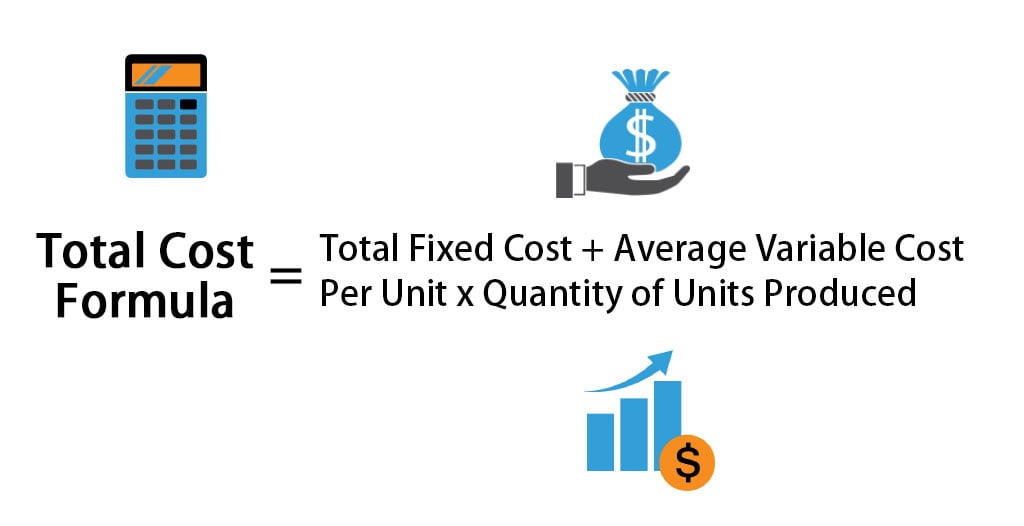
Total Cost Formula (Table of Contents)
- Formula
- Examples
- Calculator
What is the Total Cost Formula?
The term “total cost” refers to the overall cost of production that involves both fixed and variable components of cost. The total cost formula calculates the money businesses spend to manufacture, produce, and distribute goods or provide a service. Rent, salaries, and insurance are fixed costs that do not vary with output or sales volume changes. Variable expenses are those that change in response to changes in output or sales volume, such as raw materials, labor, and utilities. Furthermore, it includes all direct and indirect costs associated with the manufacturing and distribution processes, such as labor, materials, overhead expenses, taxes, etc.
The mathematical representation of the total cost formula is as follows:
Total Cost Formula = Total Fixed Cost + Total Variable Cost
However, we can further expand the total variable cost as:
Total Variable Cost = Average Variable Cost Per Unit * Quantity of Units Produced
Thus, the formula for total cost will be:
Total Cost = Total Fixed Cost + Average Variable Cost Per Unit * Quantity of Units Produced
Businesses can use the formula to determine their break-even point, which is the point at which total revenue equals total cost. It helps them determine the profitability of a product or service. They can also use it to decide pricing, production level, and cost-cutting decisions. Principally, the total fixed cost does not change over a shorter period. So the total cost of production is primarily driven by the change in average variable price per unit.
How to Calculate Total Cost Formula?
Derive the formula for total cost by using the following five steps:
Step #1: Determine the Fixed Costs
Firstly, determine the fixed cost of production, i.e., that cost that does not change with the change in the production level. Some examples of the fixed cost of production are selling expenses, rent expenses, depreciation costs, etc.
Example: A manufacturing business has fixed expenses of $45,000, including rent, advertising & distribution cost, and more.
Step #2: Find the Average Cost Per Unit
Next, determine the average variable cost per unit for those expenses dependent on the production level. Some examples of the variable cost of production are labor costs, raw material costs, etc.
Example: The business determines its variable cost per unit as $15.
Step #3: Quantify the Number of Produced Units
Next, determine the level of production or the number of units that the company produced of the product.
Example: The company produces a total of 5000 units of the product.
Step #4: Find the Total Cost
Calculate the total costs by adding the product of average variable cost per unit (step 2) and quantity of units produced (step 3) with the total fixed cost of production (step 1), as shown below.
Total Cost = Total Fixed Cost + Average Variable Cost Per Unit * Quantity of Units Produced
Example: The business’s total costs will be as follows:
Total Cost = $45,000 + $15 * 5000
= $45,000 + $75,000
= $120,000
Examples of Total Cost Formula (With Excel Template)
You can download this Total Cost Formula Excel Template here – Total Cost Formula Excel Template
Total Cost Formula – Example #1
SDF Ltd is a company engaged in manufacturing auto parts components. During a recent internal cost audit, the accounts department informed that the total fixed cost of production for the company is $10,000 per month while the average variable cost per unit is $5. Based on the given information, Calculate the total cost of production for the company when the quantity of monthly production is:
a) 2,000 units
b) 3,000 units
c) 5,000 units
Given,

a) For 2,000 Units
Calculate the total cost of production using the formula given below:
Total Cost = Total Fixed Cost + Average Variable Cost Per Unit * Quantity of Units Produced
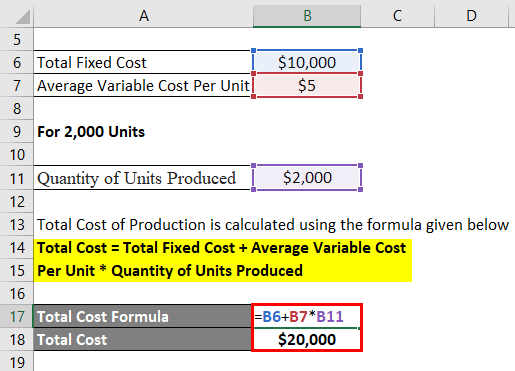
Total Cost = $10,000 + $5 * $2,000
= $20,000
b) For 3,000 Units
Calculate the total cost of production using the formula given below:
Total Cost = Total Fixed Cost + Average Variable Cost Per Unit * Quantity of Units Produced
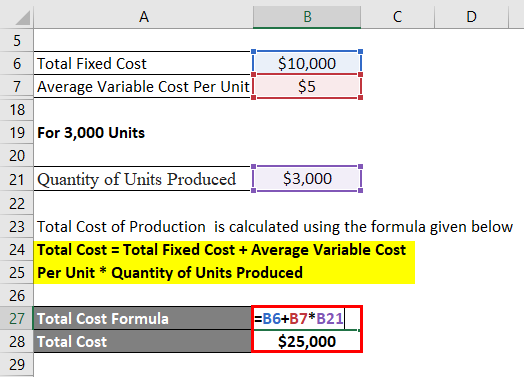
Total Cost = $10,000 + $5 * $3,000
= $25,000
c) For 5,000 Units
Calculate the total cost of production using the formula given below
Total Cost = Total Fixed Cost + Average Variable Cost Per Unit * Quantity of Units Produced
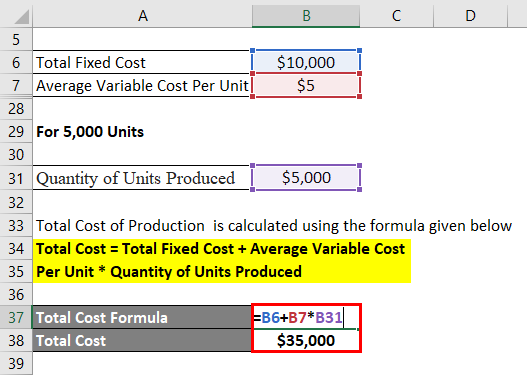
Total Cost = $10,000 + $5 * $5,000
=$35,000
In this example, the total cost of production is directly proportional to the output level.
Total Cost Formula – Example #2
A Company’s depreciation and rental expenses are $15,000 and $5,000, respectively. On the other hand, the raw material and labor costs of production per unit area are $4 and $2 per unit. Based on the given information, calculate the total cost of production when the quantity of output is:
a) 1,000 units
b) 1,500 units
c) 3,000 units
Given,
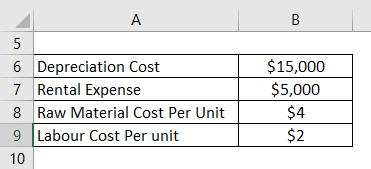
Solution:
a) 1,000 Units:
Calculate the total Fixed Cost using the formula given below
Total Fixed Cost = Depreciation Cost + Rental Expense
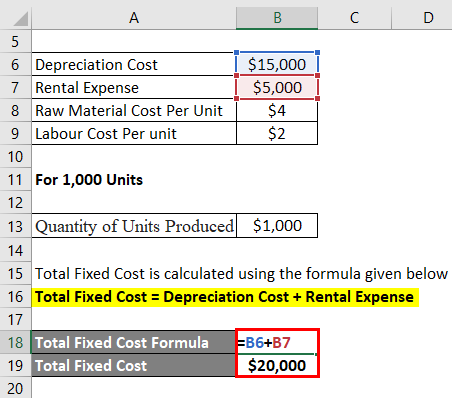
Total Fixed Cost = $15,000 + $5,000
= $20,000
Then, calculate the average Variable Cost per Unit using the formula given below:
Average Variable Cost Per Unit = Raw Material Cost Per Unit + Labour Cost Per Unit
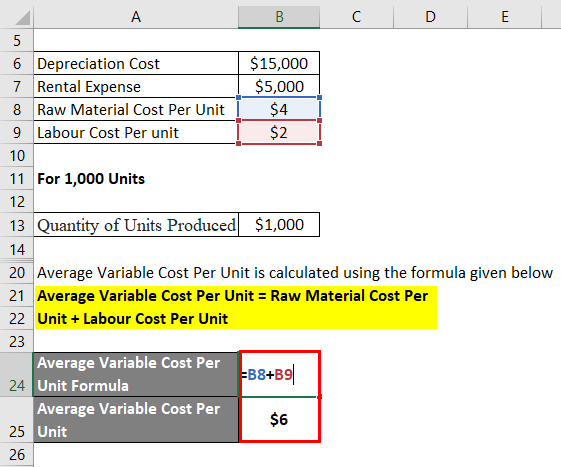
Average Variable Cost Per Unit = $4 + $2
= $6
Now, calculate the total Cost of Production using the formula given below:
Total Cost = Total Fixed Cost + Average Variable Cost Per Unit * Quantity of Units Produced
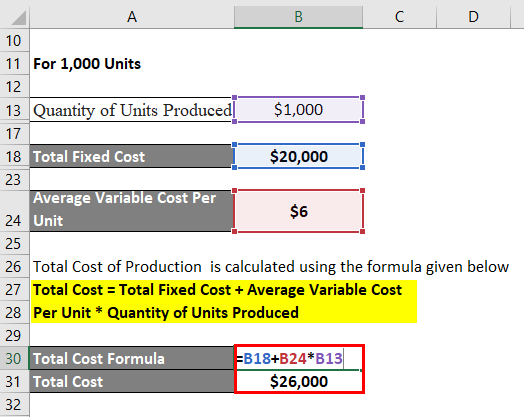
Total Cost = $20,000 + $6 * $1,000
= $26,000
b) For 1,500 Units
Calculate the total Cost of Production using the formula given below
Total Cost = Total Fixed Cost + Average Variable Cost Per Unit * Quantity of Units Produced
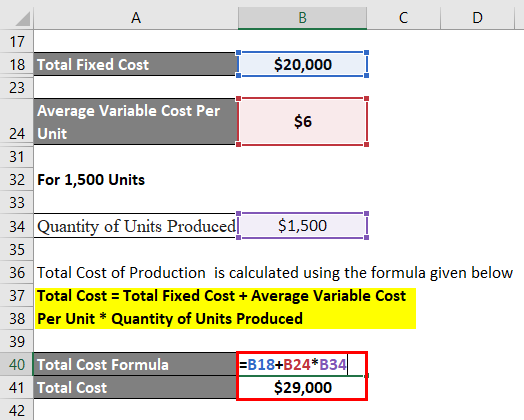
Total Cost = $20,000 + $6 * $1,500
= $29,000
c) 3,000
Calculate the total Cost of Production using the formula given below
Total Cost = Total Fixed Cost + Average Variable Cost Per Unit * Quantity of Units Produced
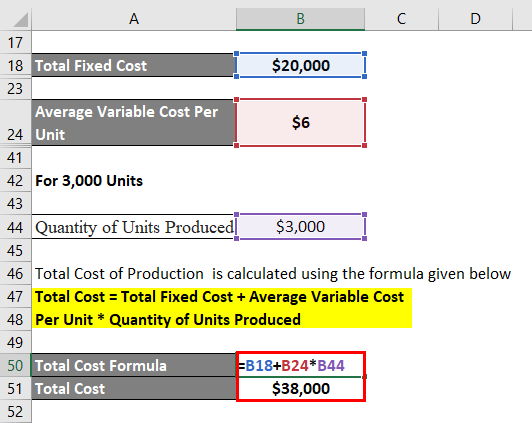
Total Cost = $20,000 + $6 * $3,000
= $38,000
Total Cost Calculator
You can use the following Total Cost Calculator
| Total Fixed Cost | |
| Average Variable Cost Per Unit | |
| Quantity of Units Produced | |
| Total Cost | |
| Total Cost = | Total Fixed Cost + Average Variable Cost Per Unit * Quantity of Units Produced | |
| 0 + 0 * 0 = | 0 |
Real-life Applications of Total Cost Formula
This formula is widely used in many industries to calculate the costs of various activities and projects. Here are some examples of how this cost formula is useful in multiple sectors:
1. Manufacturing: Manufacturers can determine the selling price and quantity of product required to make a profit by knowing the total cost. They can include variables like raw materials, labor, and overhead costs while calculating the total costs.
Example: Company A calculates its total costs to set the selling price for its newest product to enhance its profitability.
2. Construction: In the construction industry, contractors can use the cost formula to estimate the cost of a construction project accurately. It helps them create an accurate budget, make informed resource allocation decisions, and ensure the project finishes within the specified timeframe and budget.
Example: A construction business determines its total costs to budget its latest construction project effectively.
3. Healthcare: Medical professionals in the healthcare industry use the cost formula to calculate the cost of medical services, which includes the cost of supplies, equipment, and labor. Further, Healthcare providers can determine their charges to cover expenses and ensure financial viability.
Example: Doctor Shawn working at a clinic, totals his costs to accurately charge his patients to cover all his bills and maintain financial stability.
4. Retail: Companies in the retail industry use the cost formula to calculate the cost of goods sold (COGS) by factoring in the prices of purchasing, storing, and shipping inventory to customers. Hence, by knowing the COGS, retailers can determine their profit margin and make informed pricing, inventory management, and marketing decisions.
Example: A retail textile business computes its total costs to set a profitable pricing and management strategy.
Total Cost Formula in Business Decision-Making
This formula is essential in business decision-making, allowing companies to make informed pricing, budgeting, and production planning decisions.
- Pricing: Understanding the total cost of manufacturing and delivering a product or service is critical in determining its selling price. Companies can use this formula to ensure that their prices cover all their expenses while allowing them to generate profit.
- Budgeting: This formula can assist businesses in accurately estimating the costs associated with a specific project or activity. This information is critical for creating a budget and allocating resources effectively.
- Production Planning: The cost formula assists businesses in understanding the relationship between production levels and costs. The data helps plan production schedules and determine the optimal output level to maximize efficiency and profitability.
Common Mistakes to Avoid While Calculating Total Cost
Here are a few common errors to avoid when calculating total cost:
- Not including all relevant costs: When calculating total cost, it is critical to consider all costs associated with a specific project or activity. Failing to include relevant costs can result in incorrect calculations, potentially damaging business decisions.
- Misclassification of fixed and variable costs: It is critical to distinguish between fixed and variable costs and correctly classify them. Confusion over these costs can result in incorrect calculations and impact pricing and budgeting decisions.
- Failure to account for inflation: Failure to account for inflation can lead to underestimating total costs. Hence, to ensure accurate calculations, it is critical to account for inflation.
- Overlooking indirect costs: When calculating total costs, businesses frequently overlook indirect costs such as overhead expenses, administrative expenses, and marketing costs. They can, however, significantly impact the overall cost of a project or activity.
- Using only the cost formula: While the cost formula is helpful, it is also essential to consider other cost formulas, such as average and marginal costs, when making business decisions.
Total Cost vs. Average Cost vs. Marginal Cost Formula
The difference between the total cost, average cost, and marginal cost formula is as follows:
|
Particulars |
Total Cost | Average Cost |
Marginal Cost |
| Definition | It ascertains a business’s total cost in producing products and services. | The average cost formula determines the average cost per output unit. | The marginal cost formula calculates the cost of producing one additional output unit. |
| Formula | Total Cost is the sum of all fixed and variable costs of a business. | Average Cost divides by the total cost by the total units manufactured. | Marginal Cost divides the change in cost by the change in quantity. |
| Purpose | It gives a complete picture of all costs associated with a project or activity and helps companies make effective business decisions. | Average Cost is beneficial for calculating the profitability of individual products and services and setting prices. | It is essential in determining the optimal level of output and can assist businesses in avoiding overproduction by helping them pick the optimal production level. |
Advantages and Disadvantages of Total Cost Formula
|
Advantages |
Disadvantages |
| Helps with Cost Control: The cost formula assists businesses in accurately calculating their costs and identifying areas for cost savings, allowing them to control their expenses better. | Complex: Businesses that offer multiple products or services with many cost components may find the cost formula complicated, making it difficult to calculate and analyze the cost accurately. |
| Helps with Decision Making: The cost formula provides valuable information businesses can use to make informed pricing, production level, and resource allocation decisions. | Assumptions: The cost formula relies on certain assumptions, including the relationship between production levels and costs, which may only sometimes hold in practice, resulting in inaccurate calculations and decisions. |
| Improves Efficiency: Knowing the total cost allows businesses to identify areas where they can improve efficiency and reduce waste, leading to increased profitability. | Does Not Consider External Factors: The formula does not consider external factors, such as market changes, competition, or regulations, which can limit its utility in some situations. |
| Improved Cost Understanding: The cost formula assists businesses in better understanding their costs and how they relate to production levels, which can aid in planning. | Limited Scope: The cost formula only provides information on production and distribution costs and does not consider other factors that may impact business performance, such as customer satisfaction, brand image, and innovation. |
Frequently Asked Questions (FAQs)
Q1. What is the benefit of using the Total Cost Formula?
Answer: The cost formula has the advantage of assisting businesses in determining the actual cost of production and distribution, including both direct and indirect costs. This data is critical for making informed pricing, production level, and resource allocation decisions, which can help to improve profitability and competitiveness.
The concept of the total cost of production is essential as it helps production managers assess the overall profit margin at different production levels. It also determines the company’s profitability and is beneficial for all businesses.
Q2. What is the Total Cost Formula example?
Answer: The cost formula is as follows:
Total Cost = Fixed Costs + Variable Costs
For example, if a company has $100,000 in fixed costs and $50 in variable costs per unit and produces 2,000 units, the total cost would be:
Total expense = $100,000 + ($50 x 2,000) = $200,000
Q3. Explain the Total Cost Formula in the EOQ.
Answer: In the Economic Order Quantity (EOQ) model, the cost formula determines the optimal order quantity for a business to minimize total inventory costs. The procedure is as follows:
Total Cost = Ordering Cost + Holding Cost
Where Ordering Cost denotes the cost of placing an order and Holding Cost denotes the cost of stocking inventory. Businesses can find the most cost-effective order quantity to balance the cost of holding inventory and the cost of ordering by minimizing the total cost.
Q4. What is the Total Cost Formula in economics?
Answer: The cost formula in economics is the sum of all costs incurred by a business in producing and selling a specific quantity of goods or services. The formula of total cost equals fixed plus variable costs.
Q5. Differentiate between the fixed and variable total cost formulas.
Answer: The fixed cost is an expense that remains constant regardless of production levels, like rent, salaries, insurance, and depreciation. The total variable cost, on the other hand, is an expense that varies with the production level, such as raw materials, labor, and sales.
Recommended Articles
This is our guide to Total Cost Formula along with practical examples for calculation and a downloadable excel template. You may also look at the following articles to learn more:
- How to Calculate Equity Value using Formula?
- What is Formula to calculate Taxable Income?
- Calculation of Effective Tax Rate
- Examples of Correlation Formula
Download Article
Download Article
In the world of finance, when someone refers to “total cost,” she can be talking about several things. She may be referring to the costs of running a business, the costs included in one individual’s personal budget, or even the costs of something being proposed (like a stock market investment.) Luckily, no matter what you’re calculating the “total cost” for, your basic approach will be similar — simply add the fixed costs (the minimum costs required to function) to the variable costs (the costs that rise and fall at your discretion).
-

1
Calculate your fixed costs. Start finding your total cost of living by tallying up all of your fixed costs for the time period you’re looking at. Note that most (but not all) personal budgets are calculated monthly.
- In this case, fixed costs are expenses that must be paid every month. These include rent, utilities, phone bills, gasoline for the car, groceries, and so on. Fixed costs do not change very much (if at all) from month to month.These are costs that don’t increase or decrease depending on how much personal spending you do in a month — for instance, if you go on a shopping spree at your favorite clothing store, your rent won’t go up.
- As an example, let’s say that we need to put together a personal budget to save money. In our case, our fixed costs are: rent = $800, utilities = $250, phone bill = $25, internet bill = $35, gasoline for commuting to work = $200, and groceries = $900. Adding these up, we find that our total fixed costs are $2210.
-

2
Add up your variable costs for one month. In contrast to fixed costs, variable costs depend on your lifestyle and include all expenses that are not strictly necessary, but that improve your quality of life.
- Variable costs include expenses like shopping trips, nights out, clothing (beyond what you need), vacations, parties, gourmet food, etc. Note that, even though expenses like utility bills can vary slightly from month to month, they aren’t variable costs because they’re not optional.
- In our example situation, let’s say that our variable costs include: money for theater tickets = $25, weekend vacation = $500, dinner party for a friend’s birthday = $100, and a new pair of shoes = $75. This would bring our total variable costs to $700.
Advertisement
-

3
Add your fixed costs to your variable costs to get your total cost. Your total cost of living on your budget is the total amount of money you spent over a one month period. The formula for finding this is simply fixed costs + variable costs = total cost.
- Using the examples of fixed costs and variable costs given above, we would calculate our total cost as follows: $2210 (fixed costs) + $700 (variable costs) = $2910 (total cost).
-

4
Track your spending to determine your monthly expenses. Unless you’re already practicing very good financial habits, you may not keep track of every single expense in a given month. This means that you can run into problems when you have to total up all of your expenses at the end of the month. To remove guesswork from the equation, try actively tracking your expenses for one full month. After this, you’ll have a good idea of your fixed costs, so you’ll only need to track your variable costs in the future.
- Tracking fixed costs is easy — simply keep track of your housing expenses (rent, etc.) and save every major monthly bill you receive for that month and you’ll have a good deal of the work done. Groceries can be a little messier to keep track of, but if you keep your receipts or monitor your checking account transactions online, it shouldn’t be hard to get an accurate total.
- Tracking variable costs can be a little more difficult. If you use credit or debit cards to make all of your purchases, you can simply add your expenses at the end of the month by using your online banking profile (nearly all checking accounts and credit card accounts now give you this option for free.) On the other hand, if you make lots of cash or check purchases, you’ll want to save your receipts or write down the amount of money you spend with each purchase.
Advertisement
-

1
Add up your business’s fixed costs. In the world of business, fixed costs are often referred to as overhead costs. This is the money the business needs to spend simply to keep operating. More accurately, we can say that fixed costs are the costs that do not increase or decrease as the business produces more or fewer goods and services.[1]
- Fixed costs for a business are similar to (but not exactly the same as) those for a personal budget. A business’s fixed costs include rent, utilities, building leases, equipment, machinery, insurance premiums, and labor not involved in the production of the goods and services.
- Fixed costs are the costs that repeat every month.
- For example, let’s say that we own a basketball factory. Our monthly fixed costs include: building lease = $4,000, insurance premiums = $1,500, loan payments = $3,000, and equipment = $2,500. In addition, we pay $7,000 per month for workers that don’t directly affect the production of our basketballs — janitors, security guards and so on. Adding these up, we get a value for our fixed costs of $18,000.
-

2
Figure out your variable costs. In business, variable costs are a little different than they are for personal budgets. A business’s variable costs are the expenses that are directly affected by the amount of goods or services produced.[2]
In other words, the more a business creates (in terms of products produced, services rendered, and so on), the greater its variable costs will be.- Variable costs for a business include things like raw materials, shipping expenses, labor that is involved in the production process, and so on.[3]
In addition, utilities can be a variable expense if they fluctuate with the output of your business. For example, since a robotic car factory uses a large amount of electricity and since the amount of electricity needed will increase as more cars are produced, utilities can be classified as a variable cost. - In our basketball factory example, let’s say that our variable costs include: rubber = $1,000, shipping = $2,000, factory worker wages = $10,000. In addition, our factory uses a large amount of natural gas for the rubber vulcanization process and this cost increases as production ramps up — this month’s utilities bill was $3,000. Adding up our expenses, we get total variable costs of $16,000.
- Variable costs for a business include things like raw materials, shipping expenses, labor that is involved in the production process, and so on.[3]
-

3
Add your fixed and variable costs to determine your total cost. As with personal budgets, the formula for calculating a business’s total costs is quite simple: Fixed Costs + Variable Costs = Total Cost.
- In our example, since our fixed costs are $18,000 and our variable costs are $16,000, our total monthly cost for the factory is $34,000.
-

4
Find your business’s costs on its income statement. Most businesses’ fixed and variable costs can be found on their financial documents. Specifically, the income statement should contain all of the variable costs tied to the production of the business’s goods and services in addition to crucial fixed costs like rent, utilities, and so on.[4]
The income statement is a standard financial document — nearly all businesses with some sort of accounting operation should have one.- In addition, you may want to consult another document called a balance sheet to determine how much money the business needs to pay back in the future. The balance sheet contains (in addition to other important figures) a business’s liabilities — the money it owes to others. This can help you determine your business’s financial health: if you’re just barely making enough money to meet your total cost and you have major liabilities, your business may be in an unfavorable position.
Advertisement
-

1
Find the initial price of the investment. When it comes to determining the cost of an investment, your expenses usually don’t begin and end with the money you put into the stock, mutual fund, etc. For people without direct access to the stock market (i.e., most ordinary people), it’s necessary to use an investment adviser or broker to help build a portfolio and, because these experts don’t work for free, the cost will be a little higher than the money set aside for the investment. Start determining the cost of your investment by identifying the amount of money you plan to use purely for the investment.
- As an example, let’s say that we’ve recently inherited $20,000 from an obscure relative and that, rather than squandering it all on a luxurious vacation, we want to invest half of it in the stock market to get some long-term potential out of it. In this case, we’ll say that we are investing $10,000.
-

2
Account for any fees. As noted above, investment advisers don’t usually work pro bono. Generally, an adviser will need to be paid in one of two ways: via a flat fee (usually hourly) or via a commission (usually a percentage of the investment).[5]
In both cases, determining the impact on the total cost is simple. For fee-based investment services, multiply the adviser’s hourly rate by the amount of time spent on your portfolio and include any minor associated fees.- For the purposes of our example, let’s say that our chosen adviser charges $250/hour (not bad — prices can easily range to $500/hour)[6]
. If she agrees that it will take two hours of work to put together our portfolio, her fee will be $500. Let’s say we need to add $100 to this in the form of various minor fees and we get a total of $600.
- For the purposes of our example, let’s say that our chosen adviser charges $250/hour (not bad — prices can easily range to $500/hour)[6]
-

3
If necessary, add the commission. Another way to pay your adviser for handling your investments is in the form of a commission. This is generally a small percentage of whatever you buy through the adviser. The more money you invest, the smaller the percentage usually is.[7]
- In our example, let’s say that, on top of her flat fee, our adviser also charges a 1% commission. This is only for example purposes — in the real world, it’s usually either one form of payment or the other, not both. In this case, since 2% of the $10,000 we want to invest is $200, we’ll add this to our total cost.
-
A word of caution: because their pay is determined by how much you buy and sell, some commissioned investment advisers have been known to act unethically, convincing clients to ditch old stocks and buy new ones frequently in an effort to line their own pockets.[8]
Only use the services of advisers that you know and trust. If all else fails, flat fee-paid advisers tend to have less of an incentive for conflicts of interest.
-

4
Account for taxes. Finally, add the cost of any government taxes incurred as part of the investment process. In the U.S., taxes can be (and are) levied on investment income after you’ve already invested your money, but, when determining the total cost of an investment, you’re generally more worried about taxes that are levied up-front.[9]
These can vary from locality to locality, so talk to a trusted investment adviser about your tax burden before you agree to invest.- In our example, let’s say that there is a 1% tax on all major investments (in the real world, again, this may or may not be the case where you live.) In this case, since 1% of $10,000 is $100, we’ll add this to our total cost.
-

5
Add it all up. Once you know your initial investment, any associated fees and commissions, and any expected taxes, you’re ready to find its total cost — simply add each individual cost together.
- Let’s solve our example problem:
- Initial investment: $10,000
- Fees: $600
- Commission: $200
- Taxes: $100
- Total: $10,900
Advertisement
Add New Question
-
Question
How do I calculate the amount as a fraction of total income?

Use the following formula to calculate a percentage: number divided by total income times 100 equals the percentage. For example, if the number in question is $100, and your total income is $1,500, divide 100 by 1,500, and multiply the result by 100 to get the percentage.
-
Question
Mpho buys four dozen eggs for R48. What’s the rate?

Eggs are often priced per dozen. If four dozen are R48, one dozen are R12.
Ask a Question
200 characters left
Include your email address to get a message when this question is answered.
Submit
Advertisement
-
Note, however, that in the example above, taxes must still be deducted from the net income to get the total profit.[10]
-
You can use your total cost to determine whether or not you are making money. For example, in factory example above, if we sell $39,000 worth of basketballs, we would have made $5,000 — a modest net income.
Advertisement
References
About This Article
Article SummaryX
To calculate total cost for a personal budget, start by tracking your spending for 1 month to determine your average monthly expenses. Once you have a good idea of how much you spend in a typical month, figure out your total cost of living by tallying up all of your fixed costs, such as rent, utilities, phone bills, gasoline for the car, and groceries. Next, add up your variable costs for 1 month, such as nights out, clothing, and vacations. Finally, add your fixed costs to your variable costs to get your total costs. To learn how to calculate the total cost for a business, keep reading!
Did this summary help you?
Thanks to all authors for creating a page that has been read 161,367 times.
Reader Success Stories
-

Serenity Gates
Jan 31, 2017
“I liked how you illustrated all the steps.”
Did this article help you?
- Что такое формула общей стоимости?
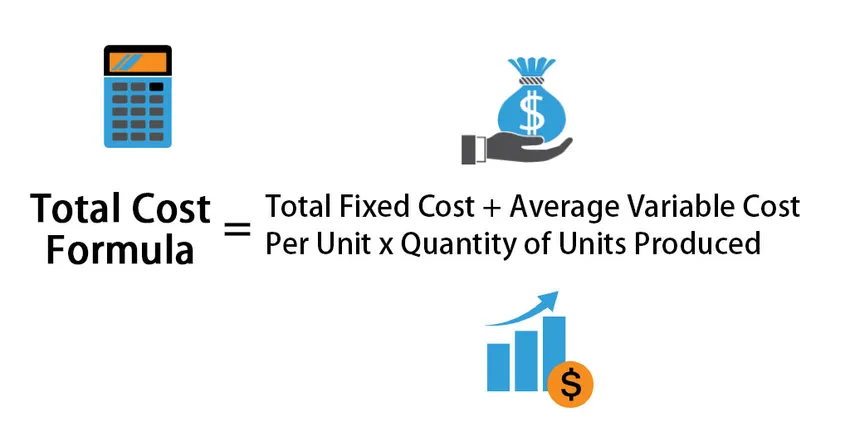
Формула общей стоимости (Содержание)
- формула
- Примеры
- Калькулятор
Что такое формула общей стоимости?
Термин «общая стоимость» относится к общей стоимости производства, которая включает как постоянные, так и переменные компоненты стоимости. Формула для общей стоимости может быть получена путем добавления общих фиксированных затрат к общей переменной стоимости. по количеству произведенных товаров. Математически это представляется как
Total Cost = Total Fixed Cost + Total Variable Cost
Тем не менее, общие переменные затраты могут быть дополнительно расширены до продукта, состоящего из нескольких единиц, с получением средних переменных затрат на единицу, как показано ниже.
Общая переменная стоимость = Средняя переменная стоимость на единицу * Количество произведенных единиц
Таким образом, формула для общей стоимости может быть представлена как показано ниже.
Total Cost = Total Fixed Cost + Average Variable Cost Per Unit * Quantity of Units Produced
Примеры формулы общей стоимости (с шаблоном Excel)
Давайте рассмотрим пример, чтобы лучше понять расчет общей стоимости.
Вы можете скачать этот шаблон Excel с общей стоимостью здесь – Шаблон Excel с общей стоимостью
Формула общей стоимости – пример № 1
Давайте возьмем пример SDF Ltd, которая занимается производством автозапчастей. Во время недавнего внутреннего аудита затрат бухгалтерия сообщила, что общая постоянная стоимость производства для компании составляет 10 000 долларов в месяц, а средняя переменная стоимость на единицу – 5 долларов. Основываясь на предоставленной информации, рассчитайте общую стоимость продукции для компании, если количество ежемесячной продукции составляет:
- 2000 единиц
- 3000 единиц
- 5000 единиц

Для 2000 единиц
Общая стоимость продукции рассчитывается по формуле, приведенной ниже
Общая стоимость = Общая фиксированная стоимость + Средняя переменная стоимость на единицу * Количество произведенных единиц
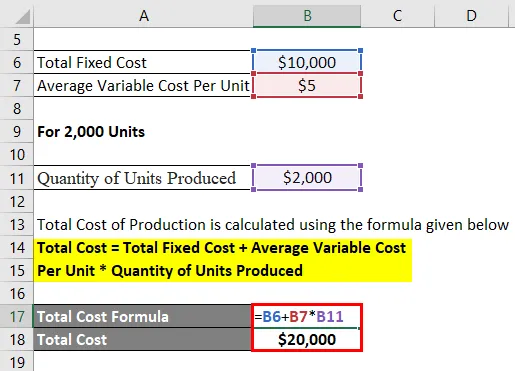
- Общая стоимость = 10 000 долл. США + 5 000 долл. США *
- Общая стоимость = 20 000 долларов
Для 3000 единиц
Общая стоимость продукции рассчитывается по формуле, приведенной ниже
Общая стоимость = Общая фиксированная стоимость + Средняя переменная стоимость на единицу * Количество произведенных единиц
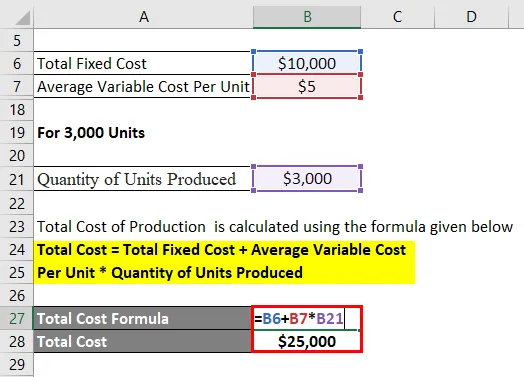
- Общая стоимость = 10 000 долл. США + 5 * 3 000 долл. США
- Общая стоимость = 25 000 долларов
Для 5000 единиц
Общая стоимость продукции рассчитывается по формуле, приведенной ниже
Общая стоимость = Общая фиксированная стоимость + Средняя переменная стоимость на единицу * Количество произведенных единиц
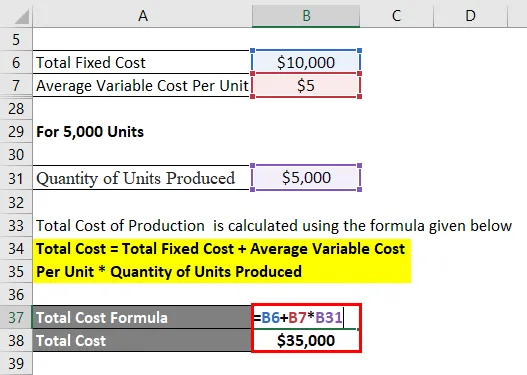
- Общая стоимость = 10 000 долларов США + 5 * 5 000 долларов США
- Общая стоимость = 35 000 долларов
В этом примере видно, что общие затраты на производство прямо пропорциональны уровню производства.
Формула общей стоимости – пример № 2
Давайте возьмем другой пример, где стоимость амортизации и расходы на аренду составляют 15 000 долларов США и 5 000 долларов США соответственно. С другой стороны, затраты на сырье и трудозатраты на производство на 4 долл. США и 2 долл. США на единицу. Основываясь на предоставленной информации, рассчитать общую стоимость продукции, когда количество продукции составляет:
- 1000 единиц
- 1500 единиц
- 3000 единиц
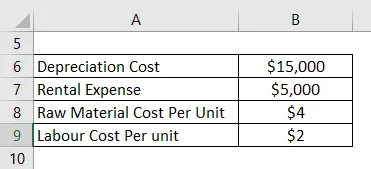
На 1000 единиц
Общая фиксированная стоимость рассчитывается по формуле, приведенной ниже
Общая фиксированная стоимость = Амортизационные отчисления + Расходы на аренду
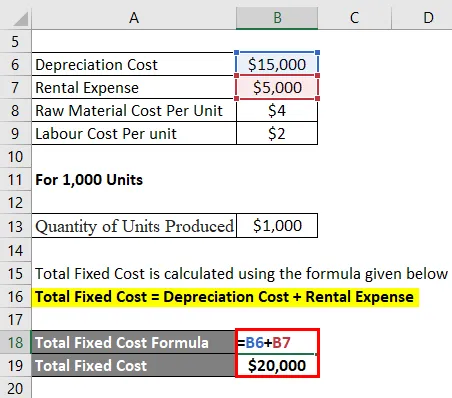
- Общая фиксированная стоимость = $ 15 000 + $ 5000
- Общая фиксированная стоимость = 20 000 $
Средняя переменная стоимость на единицу рассчитывается по формуле, приведенной ниже
Средняя переменная стоимость за единицу = стоимость сырья на единицу + стоимость труда на единицу
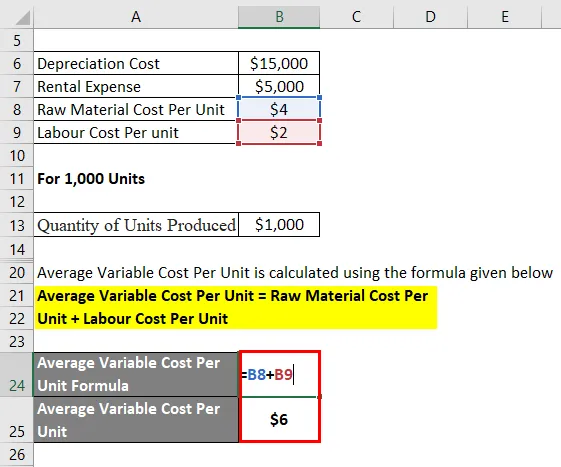
- Средняя переменная стоимость за единицу = $ 4 + $ 2
- Средняя переменная стоимость за единицу = $ 6
Общая стоимость продукции рассчитывается по формуле, приведенной ниже
Общая стоимость = Общая фиксированная стоимость + Средняя переменная стоимость на единицу * Количество произведенных единиц
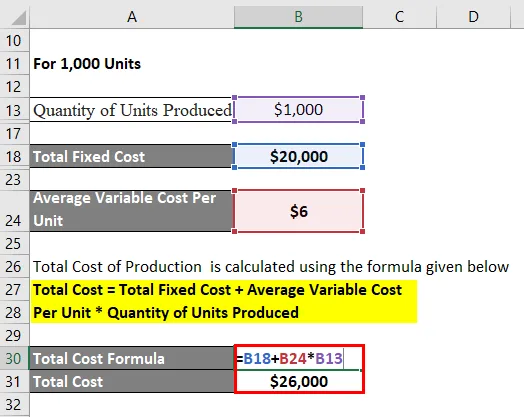
- Общая стоимость = $ 20 000 + $ 6 * $ 1000
- Общая стоимость = 26 000 долларов
Для 1500 единиц
Общая стоимость продукции рассчитывается по формуле, приведенной ниже
Общая стоимость = Общая фиксированная стоимость + Средняя переменная стоимость на единицу * Количество произведенных единиц
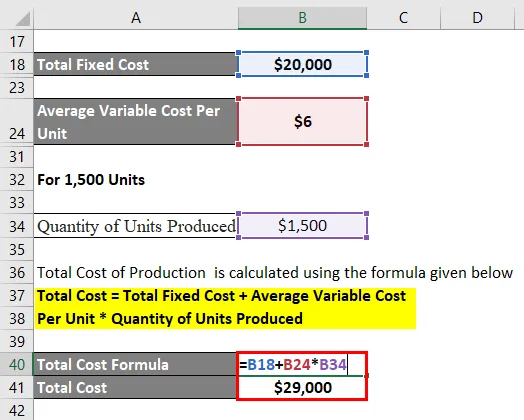
- Общая стоимость = $ 20 000 + $ 6 * $ 1500
- Общая стоимость = 29 000 долларов
Количество произведенных единиц = 3000
Общая стоимость продукции рассчитывается по формуле, приведенной ниже
Общая стоимость = Общая фиксированная стоимость + Средняя переменная стоимость на единицу * Количество произведенных единиц
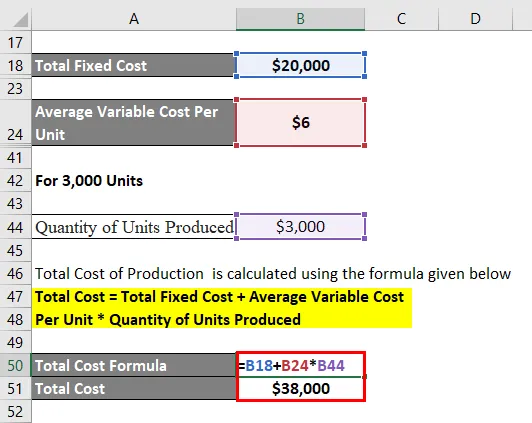
- Общая стоимость = 20 000 $ + 6 * 3 000 $
- Общая стоимость = 38 000 долларов
объяснение
Формула для общей стоимости может быть получена с помощью следующих пяти шагов:
Шаг 1: Во-первых, определите себестоимость продукции, которая носит фиксированный характер, т. Е. Те затраты, которые не меняются с изменением уровня производства. Некоторыми примерами фиксированной себестоимости продукции являются расходы на продажу, расходы на аренду, амортизационные отчисления и т. Д.
Шаг 2: Затем определите средние переменные затраты на единицу для тех расходов, которые зависят от уровня производства. Некоторыми примерами переменных затрат на производство являются стоимость рабочей силы, стоимость сырья и т. Д.
Шаг 3: Затем определите уровень производства или количество произведенных единиц.
Шаг 4: Наконец, формула для общей стоимости может быть получена путем сложения продукта средних переменных затрат на единицу (шаг 2) и количества произведенных единиц (шаг 3) с общими фиксированными затратами на производство (шаг 1), как показано ниже,
Общая стоимость = Общая фиксированная стоимость + Средняя переменная стоимость на единицу * Количество произведенных единиц
Актуальность и использование формулы общей стоимости
Концепция общей себестоимости продукции очень важно понять с точки зрения менеджеров по производству, поскольку она помогает в оценке общей прибыли на другом уровне производства. Как правило, не ожидается, что общие фиксированные затраты изменятся в течение более короткого периода, поэтому общие затраты на производство в основном определяются изменением средних переменных затрат на единицу. Тем не менее, общие постоянные затраты также одинаково важны, потому что это сумма общих постоянных затрат и общих переменных затрат, которые при вычете из выручки принесут компании прибыль. Таким образом, формула для общей стоимости очень полезна для всего бизнеса.
Калькулятор формулы общей стоимости
Вы можете использовать следующий калькулятор общей стоимости
| Общая фиксированная стоимость | |
| Средняя переменная стоимость за единицу | |
| Количество произведенных единиц | |
| Общая стоимость | |
| Общая стоимость = | Общая фиксированная стоимость + средняя переменная стоимость на единицу * Количество произведенных единиц | |
| 0 + 0 * 0 = | 0 |
Рекомендуемые статьи
Это руководство по общей стоимости формулы. Здесь мы обсудим, как рассчитать общую стоимость вместе с практическими примерами. Мы также предоставляем калькулятор общей стоимости с загружаемым шаблоном Excel. Вы также можете посмотреть следующие статьи, чтобы узнать больше –
- Как рассчитать стоимость капитала по формуле?
- Что такое формула для расчета налогооблагаемого дохода?
- Расчет эффективной налоговой ставки
- Примеры формулы корреляции
From Wikipedia, the free encyclopedia
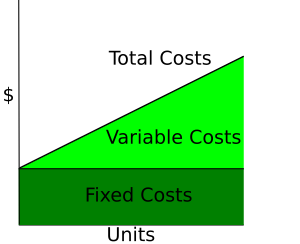

In economics, total cost (TC) is the minimum dollar cost of producing some quantity of output. This is the total economic cost of production and is made up of variable cost, which varies according to the quantity of a good produced and includes inputs such as labor and raw materials, plus fixed cost, which is independent of the quantity of a good produced and includes inputs that cannot be varied in the short term such as buildings and machinery, including possibly sunk costs.
Total cost in economics includes the total opportunity cost (benefits received from the next-best alternative) of each factor of production as part of its fixed or variable costs.
The additional total cost of one additional unit of production is called marginal cost.
The marginal cost can also be calculated by finding the derivative of total cost or variable cost. Either of these derivatives work because the total cost includes variable cost and fixed cost, but fixed cost is a constant with a derivative of 0.
The total cost of producing a specific level of output is the cost of all the factors of production. Often, economists use models with two inputs: physical capital, with quantity K and labor, with quantity L. Capital is assumed to be the fixed input, meaning that the amount of capital used does not vary with the level of production in the short run. The rental price per unit of capital is denoted r. Thus, the total fixed cost equals Kr. Labor is the variable input, meaning that the amount of labor used varies with the level of output. In the short run, the only way to vary output is by varying the amount of the variable input. Labor usage is denoted L and the per unit cost, or wage rate, is denoted w, so the variable cost is Lw. Consequently, total cost is fixed cost (FC) plus variable cost (VC), or TC = FC + VC = Kr+Lw. In the long run, however, both capital usage and labor usage are variable. The long run total cost for a given output will generally be lower than the short run total cost, because the amount of capital can be chosen to be optimal for the amount of output.
Other economic models use the total variable cost curve (and therefore total cost curve) to illustrate the concepts of increasing, and later diminishing, marginal return.
In marketing, it is necessary to know how total costs divide between variable and fixed. “This distinction is crucial in forecasting the earnings generated by various changes in unit sales and thus the financial impact of proposed marketing campaigns.”[citation needed] In a survey of nearly 200 senior marketing managers, 60% responded that they found the “variable and fixed costs” metric very useful.[1]
Calculating cost functions[edit]
- Total product (= Output, Q) = Quantity of goods
- Average Variable Cost (AVC) = Total Variable Cost / Quantity of goods (This formula is cyclic with the TVC one)
- Average Fixed Cost (AFC) = ATC – AVC
- Total Cost = (AVC + AFC) X Quantity of goods
- Total Variable Cost = Variable cost per unit X Quantity of goods
- Total Fixed Cost = TC – TVC
- Marginal Cost = Change in Total Costs / Change in Quantity of goods
- Marginal Product = Change in Quantity of goods / Change in Variable Factor
- Marginal Revenue = Change in Total Revenue / Change in Quantity of goods
- Average Product = Quantity of goods / Variable Factor
- Total Revenue = Price X Quantity of goods
- Average Revenue = TR / Quantity of goods
- Total Product = AP X Variable Factor
- Profit = TR – TC or (P-ATC)*Q
- Loss = TC – TR (if positive)
- Break Even Point: value of Quantity of goods where Average Revenue = Average Total Cost
- Profit Maximizing Condition: Marginal Revenue = Marginal Cost
- Marginal Revenue =The rate of change in Total Revenue with Quantity
See also[edit]
- Semi-variable cost
- Cost curve
- Total cost of acquisition
- Total cost of ownership
- Environmental full-cost accounting
References[edit]
- ^ Farris, Paul W.; Neil T. Bendle; Phillip E. Pfeifer; David J. Reibstein (2010). Marketing Metrics: The Definitive Guide to Measuring Marketing Performance. Upper Saddle River, New Jersey: Pearson Education, Inc. ISBN 0-13-705829-2. The Marketing Accountability Standards Board (MASB) endorses the definitions, purposes, and constructs of classes of measures that appear in Marketing Metrics as part of its ongoing Common Language in Marketing Project.
2. Fuss, M. A. (1987, January 1). Production and Cost Functions. https://link.springer.com/referenceworkentry/10.1057/978-1-349-95121-5_1668-1.
